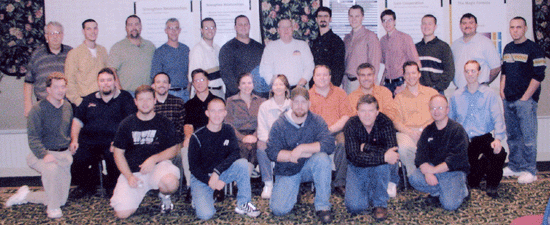What I learned at the Dale Carnegie Course
By Stephen Shannon
Printed in Practical Homeschooling #59, 2004.
 If you would like to be a leader some day, it might help to learn some leadership skills. Here is where one homeschooled student found it all.
If you would like to be a leader some day, it might help to learn some leadership skills. Here is where one homeschooled student found it all.

| 
|

 Where can high school students get important public speaking training
and practice? Where can they learn to improve their human relations
skills? Where can they learn to handle stress and worry? Where can they
do it in a positive, supportive environment? The answer: The Dale
Carnegie Course. This past summer I, at that time a junior in high
school, took the course and received enormous benefits from it.
Where can high school students get important public speaking training
and practice? Where can they learn to improve their human relations
skills? Where can they learn to handle stress and worry? Where can they
do it in a positive, supportive environment? The answer: The Dale
Carnegie Course. This past summer I, at that time a junior in high
school, took the course and received enormous benefits from it.
Through this training, I became very comfortable at speaking to
audiences of all kinds. I learned how to prepare speeches quickly and
easily, and how to deliver them with impact and poise. I learned how to
think on my feet and give impromptu talks. I learned how to communicate
my ideas clearly and concisely. I learned to use gestures to add
effectiveness to my talks. I improved my relationship with my family
members and my friends. I also learned how to decrease the amount of
worry and stress in my life, and how to increase my enthusiasm. I
learned leadership skills and I greatly increased my confidence level.
On top of that, I made dozens of friends. I enjoyed myself so much that
I am currently serving in another Dale Carnegie Course as a graduate
assistant with my original instructor, Dr. Dale O. Ferrier.
What is the Dale Carnegie Course? To understand the course, you first
need to understand the man. Dale Carnegie was a rural schoolteacher and
salesman who moved to New York City to become an actor in the early
1900’s. Failing at that, he realized that he was an excellent
public speaker, and began giving public speaking classes for adults at
the New York YMCA. His classes became very popular, because many people,
especially businessmen, needed public speaking skills. Dale Carnegie
quickly discovered that there were several other things that people
hoped to learn from his course. Many wanted to increase their
interpersonal communication skills. Others were working to increase
their self-confidence and their ability as leaders, and to decrease
their job stress. Almost all of them wanted to improve their human
relation skills. As a result, Dale decided to integrate these skills
into his public speaking class.
In order to teach human relation skills, Dale Carnegie researched it
thoroughly. To do that, he spent years interviewing some of the most
successful businessmen and leaders of his time, people such as Henry
Ford, J.C. Penney, and Charles Schwab, one of the greatest managers in
American history. He also studied the lives of people such as Abraham
Lincoln, Benjamin Franklin, and St. Paul the Apostle. Dale Carnegie
gathered the knowledge he got from his research into his book, How to
Win Friends and Influence People, and condensed it into thirty
principles on human relation skills. Dale Carnegie also formed another
thirty principles on conquering worry and wrote another book, How to
Stop Worrying and Start Living.
Since the first official Dale Carnegie course in New York in 1912, the
availability of the course has steadily expanded. It can be taken all
over the United States and in many other countries. Even though Dale
Carnegie died in 1955, the course still holds closely to his original
ideas. His book, How to Win Friends and Influence People, the original
textbook for the course, is one of the most widely read books in the
world.
The modern Dale Carnegie Course is divided into twelve sessions that are
held in the evening once a week. Each session is about three and
one-half hours long, and is taught by an instructor who has been trained
and qualified to teach the course by Dale Carnegie & Associates. Each
class has anywhere from twenty-five to forty-five students in ages
ranging from sixteen to sixty. The students come from diverse
backgrounds and careers. Many are business managers, executives, and
sales marketers. Others are blue collar workers such as industrial
foremen. The focus of the course is to help the students develop these
five objectives: build greater self-confidence, strengthen people
skills, enhance communication skills, develop leadership skills, and
control worry and stress.
Public Speaking
Public speaking is a major part of the course and the main tool used to
help the students reach the objectives. At every session everyone gives
at least one talk, usually a two-minute one. The topics are simple and
easy to prepare. For example, in session four, the students give a
report on an achievement or goal which they had worked towards and
attained. I talked about how I spent three and one-half years taking
martial arts lessons, and finally achieved the rank of Black Belt.
The instructor of the course always gives encouragement and coaching to
the participants in order to help them improve. Often, the classes start
with a brief warm-up, in which the students give a short,
easily-remembered talk and practice broad gestures.
I can see from my fellow students that anyone who goes through the
course, whether they are good or poor at public speaking, will come out
many times better.
Confidence
As important as the public speaking is the focus on increasing
self-confidence. The primary way the course does so is by gradually
pushing the students out of their comfort zones. All people have certain
things that they are comfortable and confident doing, and things that
they are uncomfortable doing. For example, at my very first Dale
Carnegie meeting, I was asked, like everybody else, to stand and tell
everybody my name and a little about myself. I was not uncomfortable
doing that since I had done it often enough on other occasions. Later,
in the same class, I was asked to give a one-minute talk on how I hoped
to benefit from the Dale Carnegie Course. Since that was something I
didn’t do very often, I felt a little uncomfortable. Now suppose I
had been asked to stand up alone in front of all the people and give a
long talk on nuclear physics! That would have been very far out of my
comfort zone.
The instructor of the course is always working to gently push the
students farther and farther outside their comfort zones, until they are
confident at doing things that would once have made them nervous. Before
I took the Dale Carnegie Course, I would have been very nervous if I had
to address a group of strangers. Now, I would only be mildly nervous.
People Skills
The thirty human relations principles are an integral part of the Dale
Carnegie Course. Dale Carnegie arranged his ideas in principles is so
that they are easy to remember and to apply in our day-to-day dealings.
The first and most important principle is, “Don’t criticize,
condemn or complain.” Criticizing, condemning and complaining are
all negative. They put other people down, discourage them, and made them
feel defensive. Instead, Dale Carnegie formulated principles such as
these: “Give honest, sincere appreciation,” and, “Try
honestly to see things from the other person’s point of view,
“ and, “Call attention to people’s mistakes
indirectly.” These are much better ways of influencing another
person’s behavior.
Throughout the course, you work on memorizing the principles, applying
them at home and at work, and reporting on your success in using them.
For example, for two weeks we worked on improving relationships with
specific people. I chose my six-year-old brother Vahn, who is very
talkative and sometimes annoying. Because he talks so much, it’s
easy to ignore him, which makes him unhappy. I applied the principle
“Be a good listener.” I looked at him, listened to him, and
commented on what he was saying. Vahn actually talks less now that he
has a good listener.
Coolness, or Grace under Pressure
Here are some of Dale Carnegie’s principles on conquering worry:
“Keep busy,” “Don’t fuss about trifles,”
“Don’t worry about the past.” His “perfect way
to conquer worry” has just one word: “Pray.”
This is probably a good time to answer a question that many of you are
wondering: Is this a good course for Christians? The answer is an
emphatic “Yes!” Dale Carnegie in his book makes clear that
he is a Christian, and often mentions Jesus. Dr. Ferrier, my instructor,
is a Christian, and he has several times told the class that the Dale
Carnegie principles are based on Jesus’s Golden Rule. Most of the
students are Christian, and I think that the course has helped several
of them to apply their faith.
So, is this course good for homeschooled students? And is it good for
high-school students? Let me give you a comment I have received several
times from Dr. Ferrier and from fellow students, all of whom are older
than I am: “I sure wish that I had taken this course when I was
your age.” A high school student is on the verge of moving into
the adult world, into jobs and college. Confidence, communication
skills, and human relation skills are all very critical at this stage of
life. Homeschooled high-school students, in my experience, have more
than enough maturity to take the Dale Carnegie Course seriously and
benefit from it, as I have done.